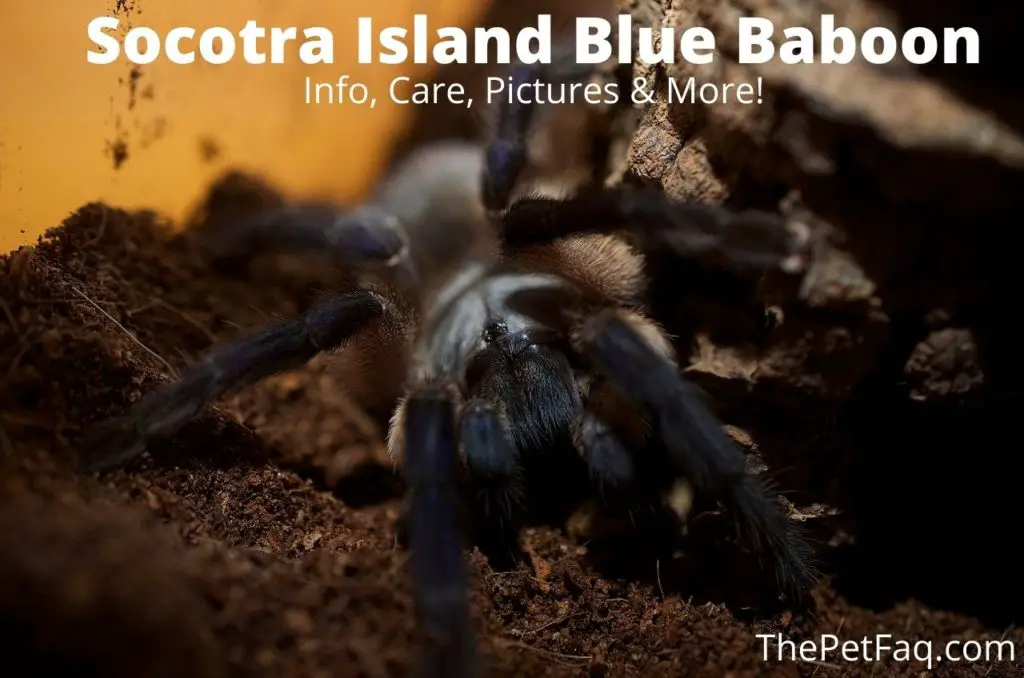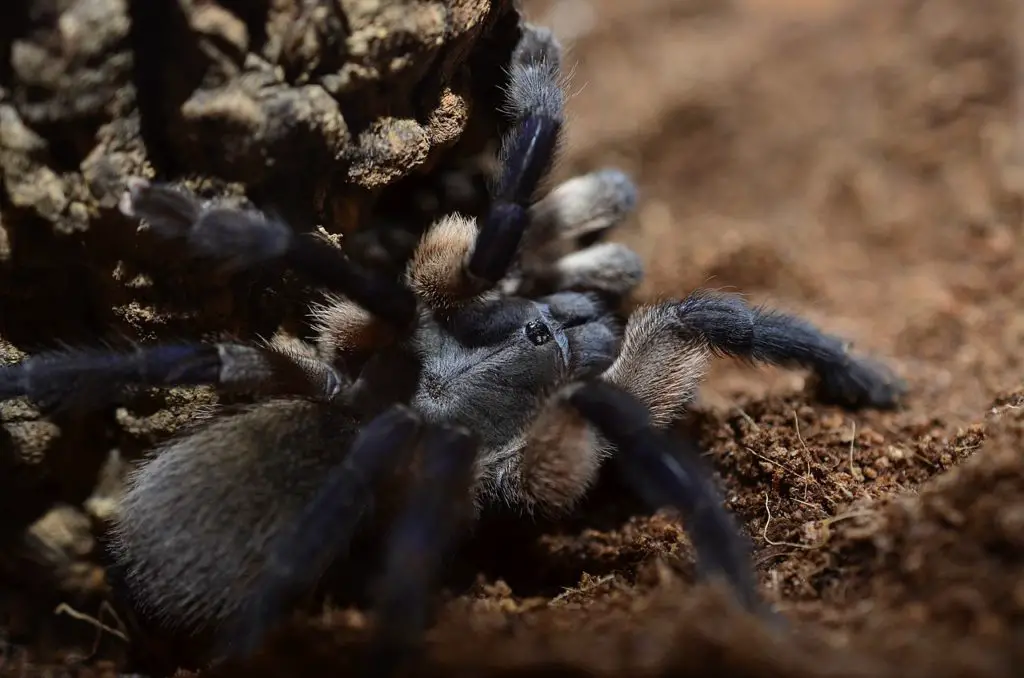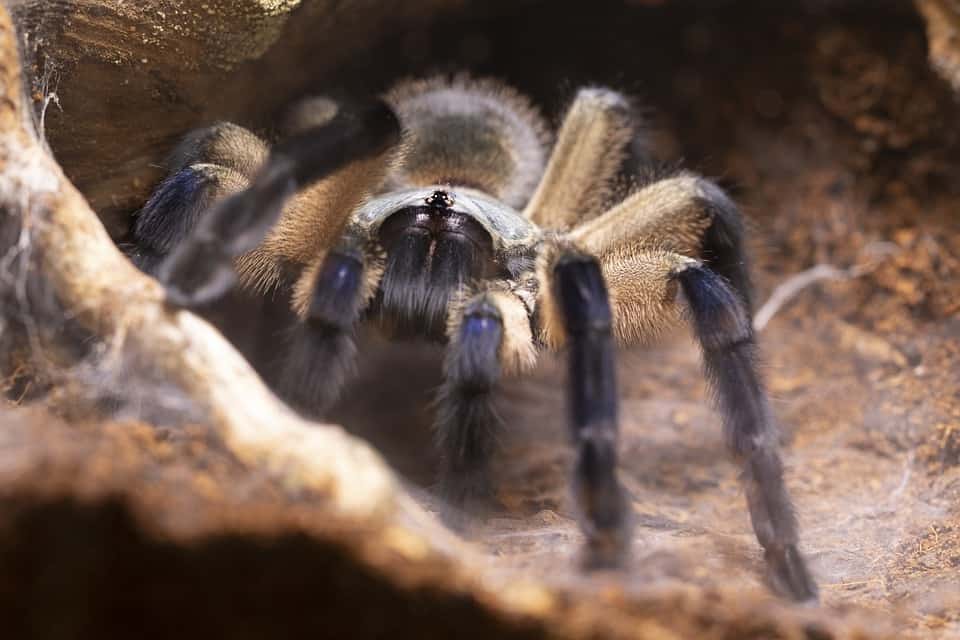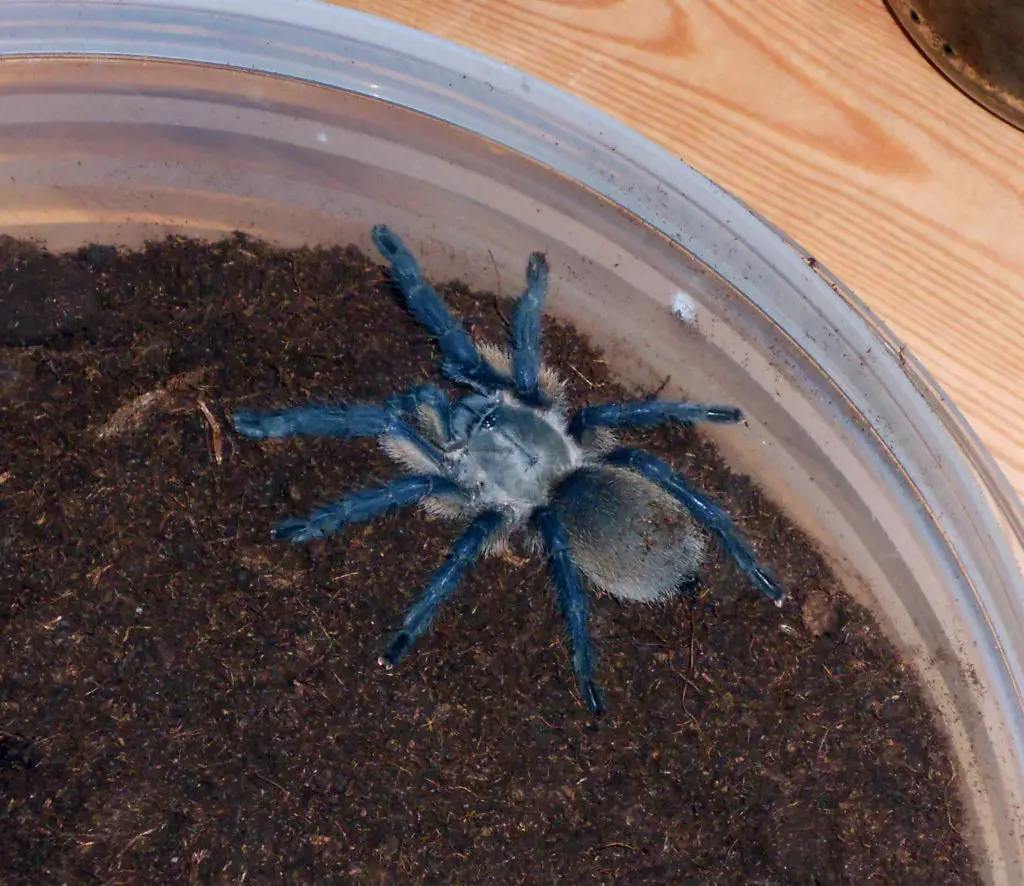The Socotra Island Blue Baboon Tarantula (Monocentropus balfouri) is an Old World species found in Socotra, an island off the coast of Yemen.
The powerful blue color of the Socotra Blue Baboon makes it a popular pet for people in the hobby. If you’ve seen pictures of this fantastic Old World tarantula and are considering getting one, here’s everything you need to know about this wonderful animal.

Socotra Island Blue Baboon Fact Sheet
| Species Name | Monocentropus balfouri |
| Family Name | Theraphosidae |
| Common Name | Socotra Island Blue Baboon, Blue Baboon Tarantula |
| Category | Old World |
| Type | Terrestrial |
| Native Location | Socotra Island, off the coast of Yemen |
| Body Length | 2.5 inches (7cm) |
| Leg Span | 7 inches (18cm) |
| Growth Speed | Medium |
| Urticating Hairs | No |
| Social | Can live together |
| Diet | Crickets, roaches, mealworms. Also feeds on small mammals/birds in the wild |
| Temperature | ~ 76°F |
| Humidity | 60-65% |
| Life Expectancy | Females, 12 to 14 years. Males, 3 to 4 years |
| Recommended Experience Level | Intermediate |
| Minimum tank size | 5 to 10 gallons |
Socotra Island Blue Baboon Tarantula Overview

The Monocentropus balfouri, known in the hobby as the Socotra Island Blue Baboon Tarantula, is a terrestrial opportunistic burrower. She’s described as being more relaxed than other Old World species; however, the fast movements and potent venom make her a bad fit for beginners. She can eat small birds if given a chance, but she’ll be happy to eat crickets and roaches in captivity.
Appearance & Variants

The Socotra Island Blue Baboon is often at the top list of beautiful spiders for tarantula enthusiasts. Her legs, and often her cephalothorax, display an electric blue color, while her abdomen shows a sandy coloration. Her body is covered with light-colored hairs that give her the appearance of being satin-soft to touch.
These spiders exhibit sexual dimorphism, so the females are different from the males. The males are smaller and are often brighter blue, while females tend to be light or grey-blue. However, these differences are too subtle to be used to identify the sex of a spider reliably. Therefore, the most reliable way to identify their sex is to check the inside of a molt.
Price
The cost of these spiders depends on whether you buy a female or a male. An unsexed or adult male can be bought for as little as $60. As they live longer, females can go for as much as $300 in some cases.
The price also depends on whether you buy a sling or an adult tarantula. Slings tend to be cheaper than subadults because they’re more difficult to raise into adulthood.
Behavior and Temperament

The Socotra Island Blue Baboon Tarantula is known for being a communal spider. Several of these spiders can share the same tank in captivity as long as they’re well-fed.
This makes it easier to store and breed them, and it allows us to have a captivating huge tank with several specimens of this spider.
For an Old World species, this arachnid is also described as being quite relaxed. She’ll sooner run and hide when she feels threatened than attack. Since this is an Old World Spider, she doesn’t have urticating hairs, but she makes up for it with fast movements and potent venom.
Her venom is considered painful but not lethal. However, if you know your way around tarantulas, the only moment you’re in actual danger of being bit is when the mature females have just laid their egg sack, and they’re protecting it. They’ll go straight to attacking at those times without displaying a warning stance first; therefore, caution is advised.
Caring for a Socotra Island Blue Baboon Tarantula
Temperature and Humidity
The Socotra Island Blue Baboon Tarantula lives in a tropical desert with temperatures over 64°F. It’s advisable to have them in captivity in an environment around 76°F and 60-65% humidity.
Some tarantula handlers struggle to keep the humidity at adequate levels. To raise the humidity you can try spraying the substrate. Alternatively, an oversized water bowl will increase the humidity through evaporation.
Substrate
The Socotra Island Blue Baboon Tarantula is a terrestrial opportunistic burrower, which means that spiderlings should get at least three inches of substrate, and both juveniles and adults should have four inches as a minimum.
They need a soft substrate for burrowing, and it can be on the dry side rather than moist, so a mixture of peat moss and coconut fiber works well for them.
Tank
Adults should be kept in three-gallon tanks that are tall enough to allow for a thick enough layer of substrate.
These opportunistic burrowers will be more comfortable if they have plenty of hiding places, so add artificial plants, bark, moss, and whatever you prefer as decoration. This will also help them make their webs, which is essential for their comfort.
If you’re going for a communal approach, the tank will have to be bigger but only slightly. These spiders don’t need three gallons each; they can be reasonably close to each other as long as each has its own space to have a web and burrow.
Molting
The Blue Baboon Tarantula grows at a medium rate. However, they will molt quite frequently when they’re young because that’s when they grow the fastest. Molting is the process of them shedding their exoskeleton to make way for a bigger one and is something all species do many times throughout their life.
Before they molt they might refuse food or water for a few days. Do not disturb your tarantula during the molting process as it’s quite a stressful time for them.
Watering
Keeping your Socotra Island Blue Baboon Tarantula hydrated isn’t difficult. You can use a water dish and refill it as soon as it gets empty. However, since these spiders produce plenty of webs, it may be uncomfortable to reach the plate.
You can also take a different approach and spray their webs with water every two or three days; that’ll also keep them hydrated; just make sure you do it with every specimen’s web if you have several living together.
Diet & Feeding
The Socotra Island Blue Baboon Tarantula is large enough to prey on small birds in the wild, but they thrive if you feed them crickets and roaches in captivity.
Spiderlings should get a flour beetle or a flightless fruit fly twice a week. Once they reach ½ an inch, you can start feeding them with one or two small crickets every five to seven days.
These spiders won’t eat if they don’t need to, and are known to stop eating for weeks before molting, so make sure to check after you feed them and remove any uneaten food they may have left. You should also wait five days after the molt to resume feeding them.
Juveniles could eat two medium crickets or one small roach every seven to ten days. Adults should be fed a larger roach or four to five adult crickets every ten to fourteen days. You should wait seven days after a juvenile or adult has molted to attempt to feed them again.
If you’re considering having several spiders in one tank, you may be lucky to see them sometimes sharing food. This only means that you need to be more aware that each specimen is getting enough food.
- Grasshoppers
- Beetles
- Crickets
- Caterpillars
- Mealworms
- Roaches
- Silkworms
- Superworms
Breeding the Socotra Blue Baboon Tarantula
Breeding the Socotra Blue Baboon Tarantula is easy; just make sure they’re correctly fed and under environmentally ideal circumstances. Don’t attempt breeding until six weeks after the female has molted, or else you risk the eggs being unfertilized.
The female will start making the egg sack around two months after meeting; you’ll notice because she’ll stop leaving her burrow. In this case, it’s better to leave the egg sack with the mother so she can take care of the eggs until they hatch.
Do note though that breeding is a complicated process and that tarantulas can have hundreds of slings at a time. If you don’t know what you’re doing, you might end up with hundreds of unwanted large spiders than can be difficult to find good homes for. Only breed spiders if you’re absolutely sure that you know what you’re doing.
Final words
If you’re considering going into the Old World Tarantula species, these spiders are a great transitioning point between New World and Old World thanks to their docile nature.
This, combined with their unique appearance and ability to live with other members of their species makes them a very interesting spider to care for.
- How Long Do American Eskimo Dogs Live? Important Factors and Care Tips - September 29, 2023
- Do American Bulldogs Need Grooming? Essential Tips and Care Guidelines - September 29, 2023
- Do Bengal Cats Enjoy Playing? Essential Tips for Keeping Them Active - September 29, 2023